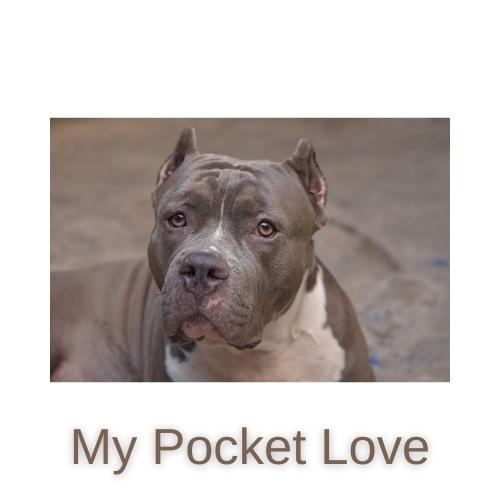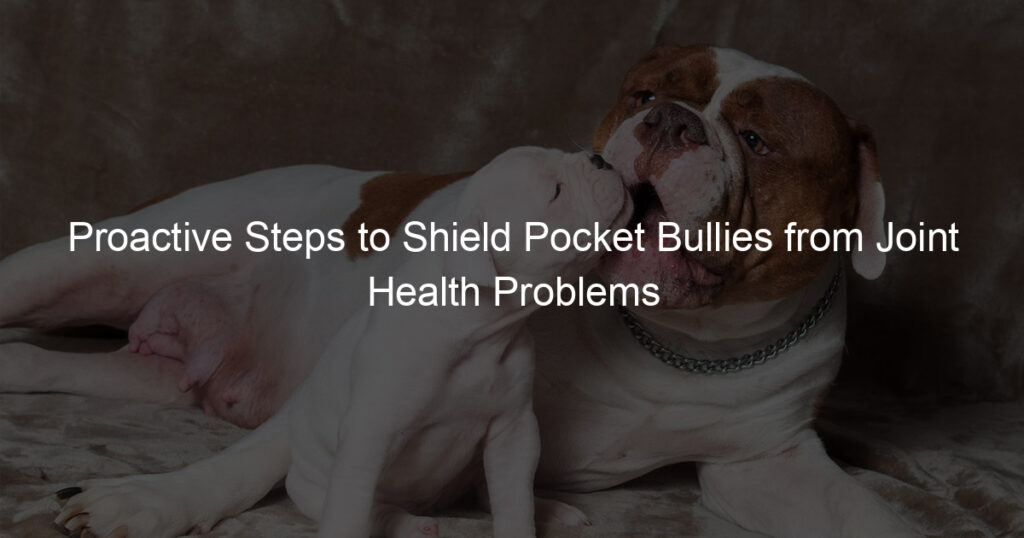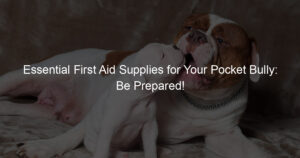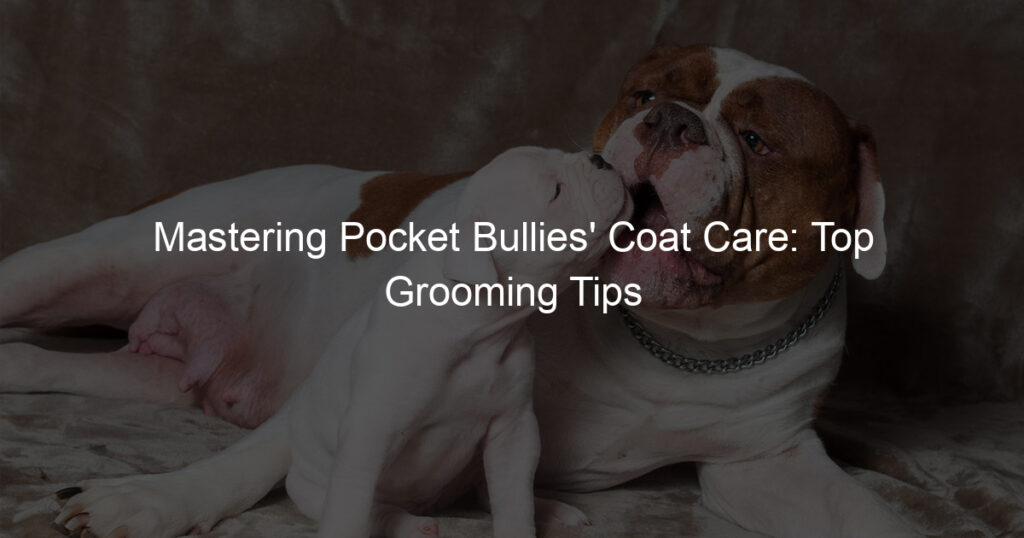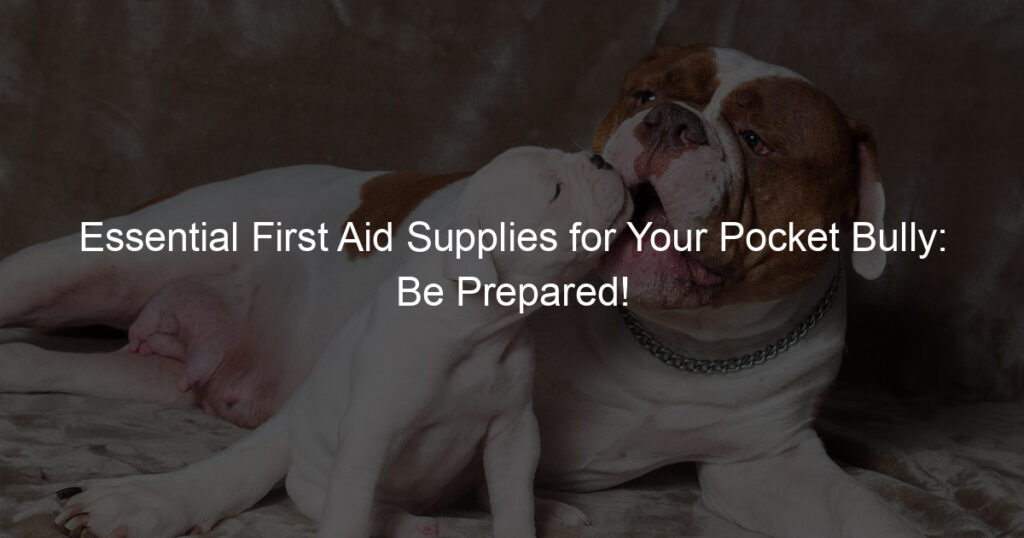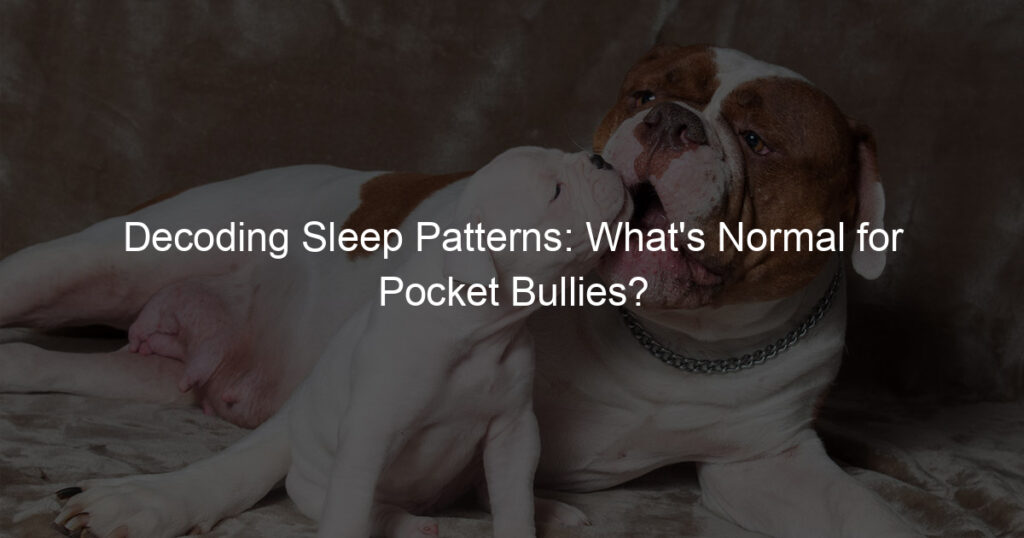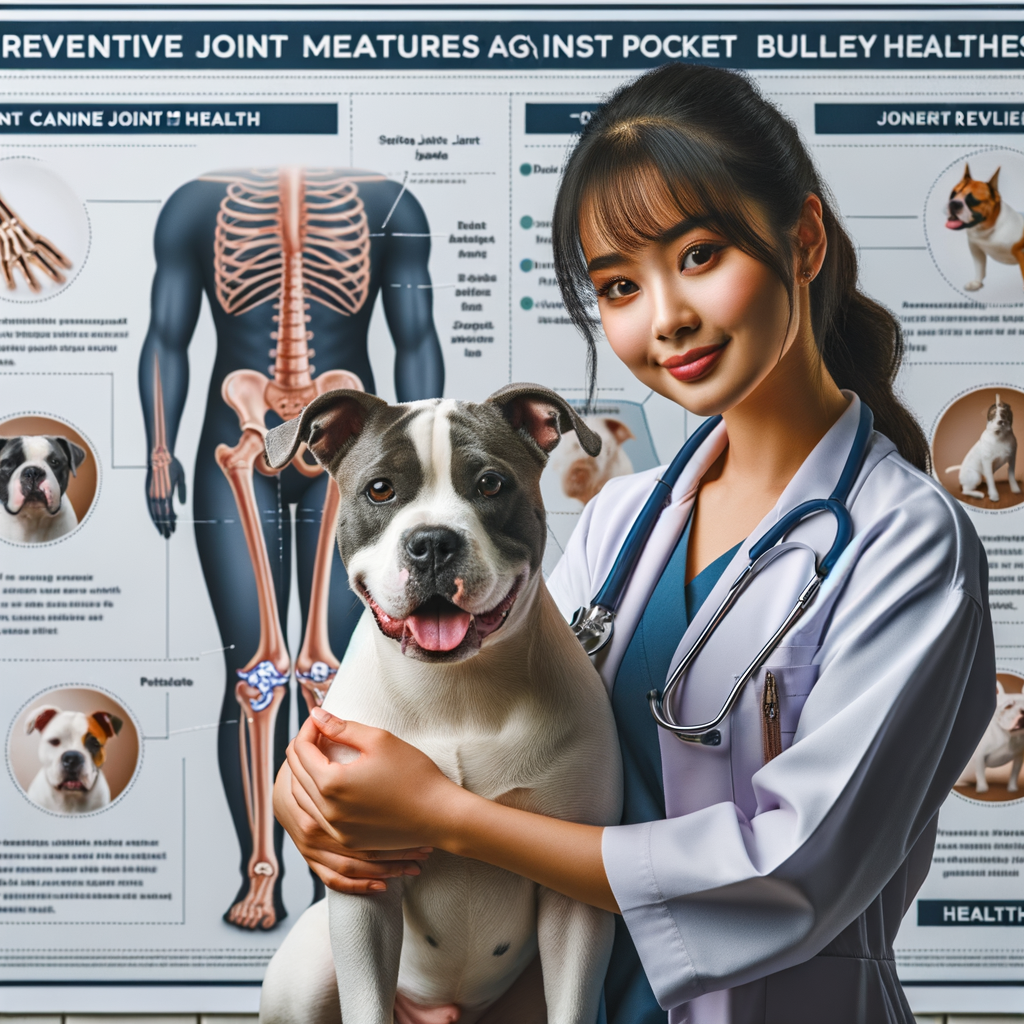
Introduction to Pocket Bullies Joint Health
When it comes to the overall health and wellbeing of Pocket Bullies, one aspect that often gets overlooked is their joint health. However, it plays a crucial role in their mobility and quality of life. In this article, we will delve into the importance of joint health in Pocket Bullies and discuss some common joint health issues that dogs often face.
- Understanding the Importance of Joint Health in Pocket Bullies
Pocket Bullies, like any other dog breed, rely heavily on their joints for movement and physical activities. Healthy joints allow them to run, jump, and play without discomfort or pain. However, due to their compact size and muscular build, Pocket Bullies are prone to certain joint health issues. If these issues are not addressed in time, they can lead to chronic pain, reduced mobility, and a significant decrease in the quality of life for these adorable pets.
Joint health is not just about preventing pain and discomfort; it also has a direct impact on a Pocket Bully’s lifespan. Dogs with healthy joints tend to live longer and lead happier, more active lives. Therefore, as a responsible pet owner, it is essential to understand the importance of joint health and take proactive steps to maintain it.
- Common Joint Health Issues in Dogs
Just like humans, dogs can suffer from a variety of joint health issues. Some of the most common ones include:
| Joint Health Issue | Description |
|---|---|
| Osteoarthritis | This is a degenerative joint disease that can cause chronic joint inflammation, pain, and stiffness. It is common in older dogs but can also affect younger dogs due to injury or genetic predisposition. |
| Hip Dysplasia | This is a genetic disorder where the hip joint does not develop correctly, leading to instability and eventual arthritis. It is common in large breed dogs but can also affect smaller breeds like Pocket Bullies. |
| Patellar Luxation | This condition occurs when the dog’s kneecap (patella) dislocates or moves out of its normal position. It can cause lameness and discomfort, and in severe cases, it may require surgical correction. |
Understanding these common joint health issues can help you spot the early signs and seek veterinary help promptly. Remember, early detection and treatment can significantly improve your Pocket Bully’s prognosis and quality of life.
Preventing Joint Issues in Pocket Bullies
As a Pocket Bullies owner, it’s crucial to understand the importance of preventing joint issues. By taking proactive measures, you can ensure your pet’s health and longevity. Let’s delve into some of these measures.
Proactive Measures for Pocket Bullies Health
There are two primary ways to maintain the joint health of your Pocket Bullies: regular exercise and a balanced diet. Both play a significant role in preventing joint issues.
- Regular exercise and its impact on joint health
- Importance of a balanced diet
Regular exercise is vital for your Pocket Bullies’ joint health. It helps to keep their joints flexible and muscles strong. Exercise can also help control your pet’s weight, reducing the strain on their joints. A study found that dogs who exercise regularly have a 35% lower risk of developing joint issues.
A balanced diet is another crucial factor in maintaining your Pocket Bullies’ joint health. The right nutrients can help build strong bones and muscles, reducing the risk of joint problems. For instance, Omega-3 fatty acids are known to reduce inflammation and help maintain joint health. A case study showed that dogs fed a diet rich in Omega-3 fatty acids had fewer joint issues compared to those on a regular diet.
In conclusion, taking proactive measures can significantly reduce the risk of joint issues in Pocket Bullies. Regular exercise and a balanced diet are key to ensuring your pet’s joint health. Remember, a healthy dog is a happy dog!
Understanding the Role of Genetics in Joint Health
Genetics play a significant role in the overall health of your Pocket Bullies, especially when it comes to their joints. Let’s delve into how genetics can influence joint health and what steps you can take if your dog is genetically predisposed to joint issues.
- How genetics can influence joint health in Pocket Bullies
- Steps to take if your dog is genetically predisposed to joint issues
Genes are like a blueprint for your dog’s body. They determine everything from your Pocket Bullies’ appearance to their health. When it comes to joint health, certain breeds, like Pocket Bullies, can be genetically predisposed to conditions such as hip dysplasia or arthritis. This means that they have a higher chance of developing these conditions because of the genes they inherited from their parents.
For example, a study conducted by the Orthopedic Foundation for Animals found that Pocket Bullies have a 20% chance of developing hip dysplasia, a painful condition that affects the hip joints. This is significantly higher than the average risk for all dog breeds, which is around 11%.
If your Pocket Bullies are genetically predisposed to joint issues, don’t panic. There are several steps you can take to help maintain their joint health and prevent issues from developing.
| Steps | Description |
|---|---|
| Regular Exercise | Regular, low-impact exercise can help keep your dog’s joints healthy. This can include activities like walking or swimming. |
| Healthy Diet | A balanced diet rich in nutrients can help support joint health. Look for dog food that contains ingredients like glucosamine and chondroitin, which are known to support joint health. |
| Regular Vet Check-ups | Regular check-ups with your vet can help catch any potential joint issues early. Your vet can also provide advice on how to best care for your dog’s joints. |
Remember, while genetics can play a role in your dog’s joint health, it doesn’t guarantee they will develop joint issues. With proper care and attention, you can help ensure your Pocket Bullies live a long, healthy, and happy life.
Maintaining Joint Health in Pocket Bullies
Keeping your Pocket Bullies healthy and active involves taking good care of their joints. Here are some tips on how to maintain their joint health.
Regular Vet Check-ups
One of the most important steps in maintaining your Pocket Bullies’ joint health is regular vet check-ups. These visits allow your vet to monitor your pet’s health and detect any potential joint issues early.
- Importance of regular vet visits for maintaining joint health
- What to expect during a joint health check-up
Regular vet visits are crucial for maintaining your Pocket Bullies’ joint health. These check-ups allow your vet to monitor your pet’s overall health and detect any potential joint issues early. Early detection is key to preventing serious joint problems and ensuring your pet’s long-term health and comfort.
During a joint health check-up, your vet will perform a physical examination of your Pocket Bullies. They will check for signs of discomfort, swelling, or limited movement in the joints. Your vet may also recommend X-rays or other diagnostic tests to get a closer look at your pet’s joints. These tests can help identify any abnormalities or changes in the joints that may indicate a problem.
Remember, regular vet check-ups are an essential part of maintaining your Pocket Bullies’ joint health. By catching potential issues early, you can help ensure your pet’s comfort and quality of life.
Supplements for Joint Health
Supplements can play a crucial role in maintaining the joint health of your Pocket Bullies. Let’s explore the types of supplements beneficial for joint health and how to choose the right one for your furry friend.
- Types of Supplements Beneficial for Joint Health
There are several types of supplements that can help improve joint health in Pocket Bullies. Here are a few:
- Glucosamine: This is a natural compound found in healthy cartilage, particularly in the fluid around the joints. For dietary supplements, it is harvested from shells of shellfish or made in a lab.
- Chondroitin: It is a substance that occurs naturally in the connective tissues of people and animals. As a supplement, it’s designed to help with joint health and is often combined with glucosamine.
- Omega-3 Fatty Acids: These are essential fats that your dog’s body can’t produce itself. They are known to have health benefits, including reducing inflammation.
- How to Choose the Right Supplement for Your Pocket Bullies
Choosing the right supplement for your Pocket Bullies can be a daunting task with so many options available. Here are a few tips to help you make the right choice:
- Consult your vet: Your vet knows your dog’s health the best. They can recommend the right type and dosage of supplement based on your dog’s age, weight, and overall health.
- Quality over price: While it might be tempting to go for cheaper options, it’s essential to choose a supplement that is high quality and from a reputable brand.
- Check the ingredients: Always check the label to ensure that the supplement contains the necessary ingredients for joint health, such as glucosamine, chondroitin, and omega-3 fatty acids.
Remember, supplements are not a cure-all, but they can help maintain your Pocket Bullies’ joint health when used in conjunction with a balanced diet and regular exercise.
Pocket Bullies Joint Problems Prevention
Preventing joint problems in Pocket Bullies is crucial to ensure their overall health and happiness. One of the key aspects of prevention is early detection of joint issues. Let’s delve into how you can identify and respond to these issues promptly.
Early Detection of Joint Issues
Early detection of joint problems can make a significant difference in your Pocket Bullies’ quality of life. It’s important to be aware of the signs and symptoms, and know the steps to take if you suspect your dog has a joint problem.
- Signs and symptoms of joint problems in Pocket Bullies
- Steps to take if you suspect your dog has a joint problem
Joint problems can manifest in various ways in your Pocket Bullies. Some common signs include difficulty in getting up, limping, or reluctance to jump or climb stairs. You may also notice a change in their gait or a decrease in activity levels. In some cases, your dog may even show signs of discomfort or pain when touched.
If you notice any of these symptoms in your Pocket Bullies, it’s important to act promptly. First, limit their physical activity to prevent further injury. Next, schedule a visit to the vet for a thorough examination. The vet may recommend tests such as X-rays or blood tests to confirm the diagnosis. Based on the results, a suitable treatment plan will be devised.
Remember, early detection and intervention can greatly improve your Pocket Bullies’ prognosis and quality of life. Stay vigilant and proactive in monitoring your dog’s health.
Rehabilitation and Therapy for Joint Issues
When it comes to joint problems in Pocket Bullies, early detection is crucial. But, what happens when your beloved pet is diagnosed with a joint issue? Thankfully, there are several types of therapy available that can help manage and even improve your dog’s condition.
- Types of therapy available for dogs with joint issues
- Physical Therapy: This involves exercises and movements designed to improve joint mobility and strength. It can be done at home or with a professional canine physical therapist.
- Hydrotherapy: This is a form of physical therapy that takes place in water. The buoyancy of the water can make movement easier and less painful for dogs with joint issues.
- Massage Therapy: This can help to relieve pain and improve circulation to the affected joints. It should be done by a professional canine massage therapist.
- Acupuncture: This ancient Chinese therapy can help to relieve pain and inflammation in dogs with joint issues. It should be done by a certified veterinary acupuncturist.
- Success stories of dogs who have recovered from joint problems
There are several types of therapy that can help dogs with joint issues. These include:
Many dogs have successfully recovered from joint problems with the help of therapy. Here are a few inspiring stories:
| Name | Breed | Therapy Used | Outcome |
|---|---|---|---|
| Max | Pocket Bully | Physical Therapy | Max’s mobility improved significantly after several months of physical therapy. He is now able to run and play without pain. |
| Bella | Pocket Bully | Hydrotherapy | After a few sessions of hydrotherapy, Bella’s joint pain reduced considerably. She is now more active and happier. |
| Charlie | Pocket Bully | Acupuncture | Charlie’s inflammation reduced after a few acupuncture sessions. He is now able to walk longer distances without discomfort. |
These stories show that with the right therapy and care, dogs with joint issues can lead a happy and active life. Always consult with your vet to determine the best course of action for your pet’s specific needs.
Conclusion: Ensuring a Healthy Life for Your Pocket Bullies
As we wrap up this comprehensive guide on joint health for Pocket Bullies, it’s important to remember the key points we’ve discussed. A healthy life for your Pocket Bullies is more than just feeding them well and giving them exercise. It also involves taking care of their joint health.
- Recap of the importance of joint health in Pocket Bullies
- Final thoughts on maintaining and improving your dog’s joint health
Joint health is crucial for Pocket Bullies due to their muscular build and active nature. Ensuring their joints are healthy can prevent painful conditions like arthritis and hip dysplasia. Remember, a healthy dog is a happy dog, and joint health plays a significant role in their overall well-being.
Regular vet check-ups, a balanced diet, and moderate exercise are the pillars of maintaining and improving your dog’s joint health. Supplements can also be beneficial, but always consult your vet before introducing any new elements into your dog’s diet. Remember, prevention is always better than cure, so start taking care of your dog’s joints today for a healthier and happier tomorrow.
In conclusion, the health of your Pocket Bullies’ joints is not something to be taken lightly. By following the tips and advice in this guide, you can ensure a long, active, and pain-free life for your furry friend. After all, they rely on us for their care, and it’s our responsibility to provide the best we can for them.
